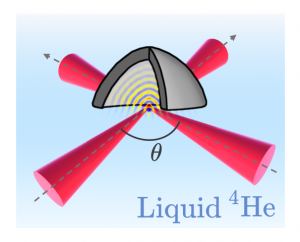SUPERFLUID HELIUM AND NEGATIVE PRESSURES
Low temperature liquid helium-4 is a model material for condensed matter physics for two reasons. First, atomic interactions are weak and quantum effects play an important role on the macroscopic scale. Secondly, liquid helium-4 can be obtained with remarkable purity. When preparing a sample of liquid helium-4 in an experimental cell, atomic or molecular impurities other than helium are frozen along the filling line of the cell or on the walls of the cell itself. It is then expected that the intrinsic properties of the liquid can be studied without being altered by the presence of impurities. In particular, liquid helium-4 is a system for probing deep into the metastable states of condensed matter and hoping to study homogeneous nucleation phenomena, i.e. not assisted by liquid impurities.
In the years 1990-2000, beautiful experiments that have become famous in the community made it possible to create metastable states of liquid helium by focusing an intense sound wave on it. In doing so, during the decompression phases of the wave, the liquid is brought to pressures below the saturated vapour pressure and is then in a metastable state. For sufficient acoustic intensities, the liquid destabilizes and a bubble appears at the acoustic focus: this is cavitation. Theoretical work has made it possible to estimate the pressure at which cavitation occurs. However, measurements are extremely difficult to carry out because of the fragility of metastable states. Estimates from experiments in the 2000s suggest that the cavitation pressure at a temperature of 1 K is negative, around -9 bar, and that nucleation is quite homogeneous. The concept of negative pressure may be surprising but is easily understood by imagining a real fluid in a container. When the fluid particles push on the walls of the container, the pressure of the fluid is positive, when they pull on it, it is negative!
During Lionel Djadaojee’s thesis, we developed a Brillouin spectrometer allowing us to measure the compressibility of a liquid on spatial scales of the order of 20 µm and temporal scales of the order of 200 ns. This allowed us to measure the compressibility of the metastable states of helium-4 produced by the acoustic methods previously described. Combined with interferometric density measurements carried out within the group a few years ago, these measurements allow us to trace the value of the pressure at the cavitation threshold.
The results, published recently in Physical Review Letters, challenge previous estimates of the cavitation pressure and suggest that, in this type of experiment, nucleation may in fact be heterogeneous. The quantized vortices of the superfluid would play the role of quantum defects at which cavitation bubbles are created.
Brillouin Spectroscopy of Metastable Superfluid Helium-4
Lionel Djadaojee and Jules Grucker
Phys. Rev. Lett. 129, 125301 https://doi.org/10.1103/PhysRevLett.129.125301


